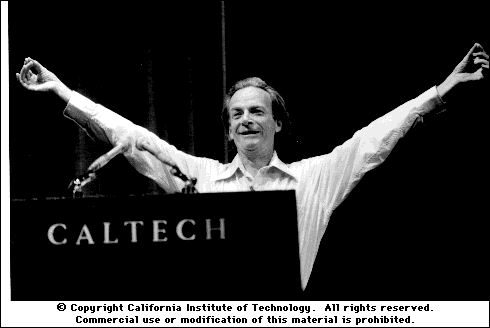Atoms in Motion

"If, in some cataclysm, all of
scientific knowledge were to be destroyed, and only one sentence passed
on to the next generation of creatures, what statement would contain the
most information in the fewest words? I believe it is the atomic
hypothesis that all things are made of atoms - little particles that move
around in perpetual motion, attracting each other when they are a little
distance apart, but repelling upon being squeezed into one another." (Feynman)
Richard Feynman made this statement
during one of his introductory lectures, at the California Institute of
technology in 1961, to a class of freshman and sophomores. In his
next ten pages of lecture notes he explains and validates this statement.
Feynman starts off by describing
the physical appearance of the atoms using water molecules as an example.
To illustrate the power
of the atomic idea, suppose that we have a drop of water a quarter of an
inch on the side. If we look at it very closely we see nothing but
water - smooth, continuous water. Even if we magnify it with the
best optical microscope available - roughly two thousand times - then the
water drop will be roughly forty feet across, about as big as a large room,
and if we looked rather closely, we would still see relatively smooth water
- but here and there small football-shaped things swimming back and forth.
Very interesting. These are paramecia. You may stop at this
point and get so curious about the paramecia with their wiggling cilia
and twisting bodies that you go no further, except perhaps to magnify the
paramecia still more and see inside. This, of course, is a subject
for biology, but for the present we pass on and look still more closely
at the water material itself, magnifying it two thousand times again.
Now the drop of water extends about fifteen miles across, and if we look
very closely at it we see a kind of teeming, something which no longer
has a smooth appearance - it looks something like a crowd at a football
game as seen from a very great distance. In order to see what this
teeming is we will see something similar to what is shown in Figure 27.
This is a picture of water magnified a billion times, but idealized in
several ways. In the first place, the particles are drawn in a simple
manner with sharp edges, which is inaccurate. Secondly, for simplicity,
they are sketched almost schematically in two-dimensional arrangement,
but of course they are moving around in three dimensions.

Feynman goes on to describe other
properties of atoms:
1 Atom's vibrating motion.
2. Atom density
in a gaseous form
3. Properties
of gas
a.
Pressure is proportional to density
b.
Gas compression
4. Properties
of solids.
5. Dissolving
6. Atom arrangement
in molecules
Home

